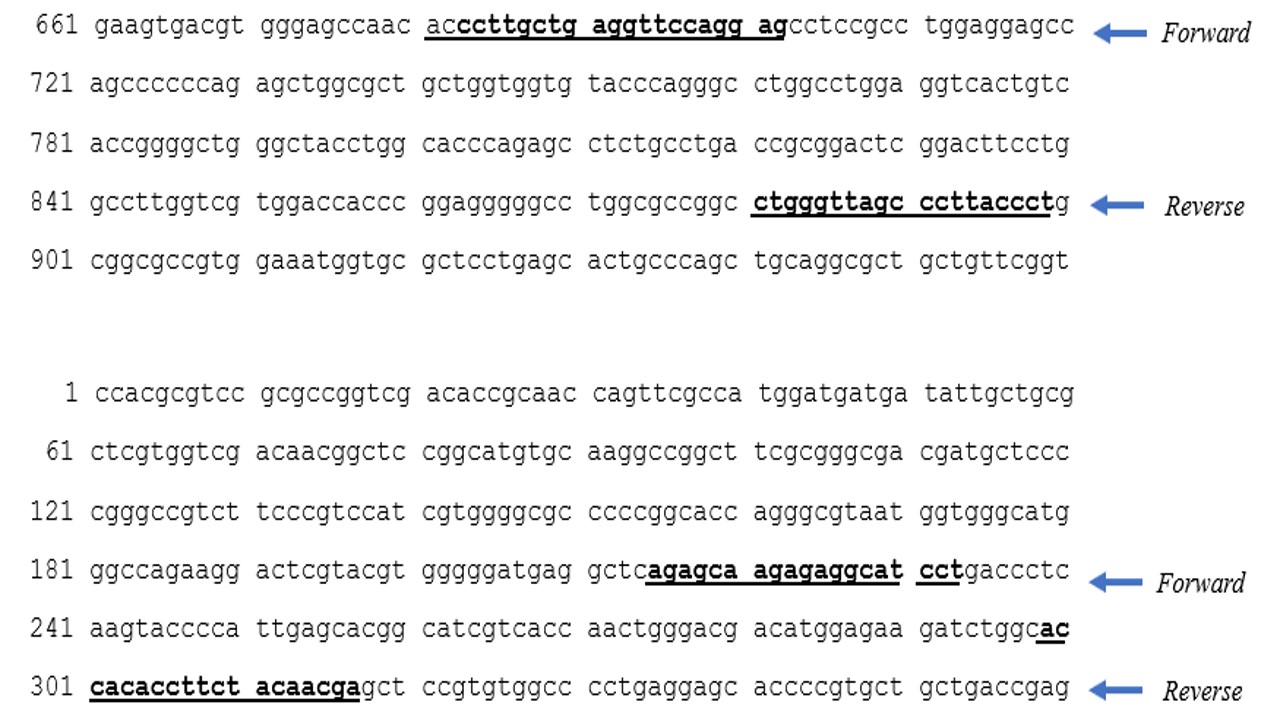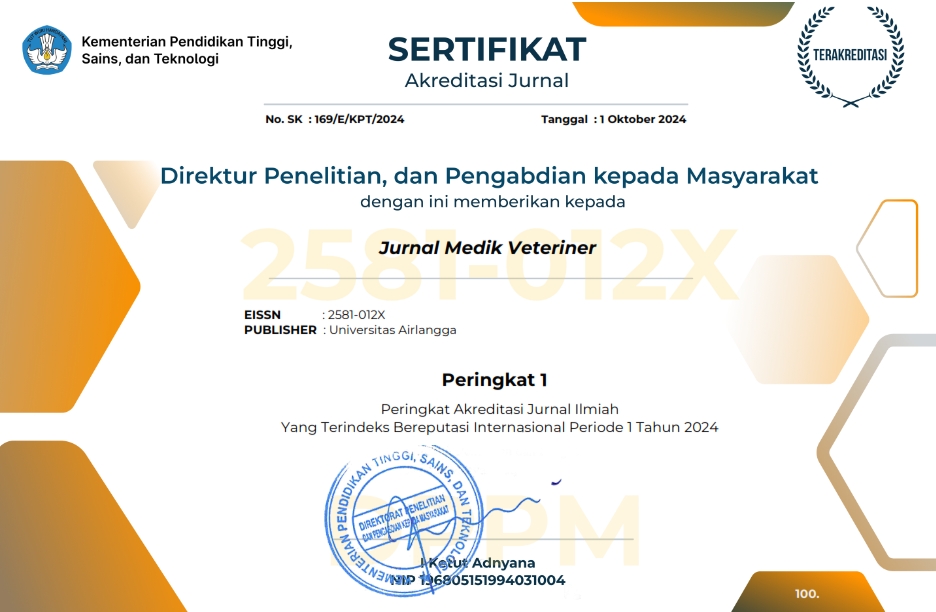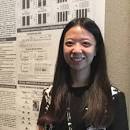Detection of Anti-Müllerian Hormone (AMH) mRNA in Serum and Ovarian Tissue of Local Indonesian Cattle Using EvaGreen-based RT–qPCR

Downloads
Anti-Müllerian hormone (AMH) has been identified as a potential biomarker for assessing ovarian reserve and reproductive capacity in cattle, with high heritability and relatively stable expression. However, studies detecting AMH mRNA in bovine serum remain scarce due to the matrix’s inherently low RNA yield, susceptibility to degradation, and potential presence of PCR inhibitors. This study provides an exploratory validation of AMH mRNA detection in serum — a challenging matrix compared with ovarian tissue — using EvaGreen-based reverse transcriptase–quantitative PCR (RT–qPCR). Specific primers for the AMH and β-actin genes were designed in silico and validated through melting curve analysis and linearity testing. The results showed high amplification efficiency (AMH: 100.2%, R² = 0.994; β-actin: 109.1%, R² = 0.996), with specific amplification of both targets. AMH detection in serum samples was successful in some samples, while the β-actin gene was consistently amplified as a reference gene. Despite the low RNA quality from serum and the presence of organic contaminants, the method demonstrated its feasibility for detecting AMH transcripts in a minimally invasive manner. Physiologically, AMH levels positively correlate with antral follicle count, superovulation success, and embryo quality, and are sensitive to heat stress and other environmental factors. These findings provide a foundational basis for developing molecular diagnostic approaches based on AMH gene expression in cattle reproductive management programs and support the future development of efficient, accurate, and context-specific biomolecular-assisted selection technologies for tropical livestock systems.
Alward, K. J., & Bohlen, J. F. (2020). Overview of anti‐Müllerian hormone (AMH) and association with fertility in female cattle. Reproduction in Domestic Animals, 55(1), 3–10.
Aziz, R. A., Khalil, A. A. Y., Abdel-Wahab, A., Hassan, N. Y., Abdel-Hamied, E., & Kasimanickam, R. K. (2017). Relationship among circulating anti-Müllerian hormone, insulin like growth factor 1, cadmium and superovulatory response in dairy cows. Theriogenology, 100, 72–79.
Barra, G. B., Santa Rita, T. H., Jardim, D. P., Mesquita, P. G., Nobre, C. S., Jácomo, R. H., & Abdalla Nery, L. F. (2019). Genotyping of single nucleotide polymorphisms using allele-specific qPCR producing amplicons of small sizes directly from crude serum isolated from capillary blood by a hand-powered paper centrifuge. Diagnostics, 9(1), 88.
Batista, E. O., Macedo, G. G., Sala, R. V., Ortolan, M. D., Sá Filho, M. F., Del Valle, T. A., Jesus, E. F., Lopes, R. N., Renno, F. P., & Baruselli, P. S. (2014). Plasma antimullerian hormone as a predictor of ovarian antral follicular population in Bos indicus (Nelore) and Bos taurus (Holstein) heifers. Reproduction in Domestic Animals, 49(3), 448–452.
Bernabucci, U., Basiricò, L., Morera, P., Dipasquale, D., Vitali, A., Cappelli, F. P., & Calamari, L. U. I. G. I. (2015). Effect of summer season on milk protein fractions in Holstein cows. Journal of Dairy Science, 98(3), 1815–1827.
Berry, D. P., Wall, E., & Pryce, J. E. (2014). Genetics and genomics of reproductive performance in dairy and beef cattle. Animals, 8(s1), 105–121.
Besenfelder, U., Brem, G., & Havlicek, V. (2020). Environmental impact on early embryonic development in the bovine species. Animals, 14(S1), s103–s112.
Boulton, A. C., Rushton, J., & Wathes, D. C. (2017). An empirical analysis of the cost of rearing dairy heifers from birth to first calving and the time taken to repay these costs. Animals, 11(8), 1372–1380.
Bustin, S. A., & Nolan, T. (2020). RT-QPCR testing of SARS-COV-2: A primer. International Journal of Molecular Sciences, 21(8), 22.
Cate, R. L., Mattaliano, R. J., Hession, C., Tizard, R., Farber, N. M., Cheung, A., Ninfa, E. G., Frey, A. Z., Gash, D. J., Chow, E. P., Fisher, R. A., Bertonis, J. M., Torres, G., Wallner, B. P., Ramachandran, K. L., Ragin, R. C., Manganaro, T. F., MacLaughlin, D. T., & Donahoe, P. K. (1986). Isolation of the bovine and human genes for müllerian inhibiting substance and expression of the human gene in animal cells. Cell, 45(5), 685–698.
Chhalliyil, P., Ilves, H., Kazakov, S. A., Howard, S. J., Johnston, B. H., & Fagan, J. (2020). A real-time quantitative PCR method specific for detection and quantification of the first commercialized genome-edited plant. Foods, 9(9), 36.
Costella, A., De Leo, R., Guarino, D., D’Indinosante, M., Concolino, P., Mazzuccato, G., Urbani, A., Scambia, G., Capoluongo, E., Fagotti, A., & Minucci, A. (2018). High-resolution melting analysis coupled with next-generation sequencing as a simple tool for the identification of a novel somatic BRCA2 variant: A case report. Human Genome Variation, 5(1), 22.
Crowe, M. A., Hostens, M., & Opsomer, G. (2018). Reproductive management in dairy cows-the future. Irish Veterinary Journal, 71, 1–13.
Daneshian, Z., Tehrani, F. R., Zarkesh, M., Zadeh, M. N., Mahdian, R., & Vakili, A. Z. (2015). Antimullerian hormone and its receptor gene expression in prenatally and rogenized female rats. International Journal of Endocrinology and Metabolism, 13(1), 56.
Eshel, O., Shirak, A., Dor, L., Band, M., Zak, T., Markovich-Gordon, M., Chalifa-Caspi, V., Feldmesser, E., Weller, J. I., Seroussi, E., Hulata, G., & Ron, M. (2014). Identification of male-specific AMH duplication, sexually differentially expressed genes and microRNAs at early embryonic development of Nile tilapia (Oreochromis niloticus). BMC Genomics, 15(1), 55.
Feres, L. F. R., Siqueira, L. G. B., Palhao, M. P., Dos Santos, L. L., Pfeifer, L. F. M., de Carvalho Fernandes, C. A., & Viana, J. H. M. (2024). Selecting oocyte donors based on anti-Müllerian hormone (AMH) concentrations: a critical analysis of using cutoff values as exclusion criterion for an in vitro embryo production program in Gir cattle. Animal Reproduction Science, 266, 107491.
Gendelman, M., Aroyo, A., Yavin, S., & Roth, Z. (2010). Seasonal effects on gene expression, cleavage timing, and developmental competence of bovine preimplantation embryos. Reproduction, 140(1), 73–82.
Ghanem, N., Jin, J. I., Kim, S. S., Choi, B. H., Lee, K. L., Ha, A. N., & Kong, I. K. (2016). The anti‐Müllerian hormone profile is linked with the in vitro embryo production capacity and embryo viability after transfer but cannot predict pregnancy outcome. Reproduction in Domestic Animals, 51(2), 301–310.
Gobikrushanth, M., Purfield, D. C., Canadas, E. R., Herlihy, M. M., Kenneally, J., Murray, M., & Butler, S. T. (2019). Anti-Müllerian hormone in grazing dairy cows: Identification of factors affecting plasma concentration, relationship with phenotypic fertility, and genome-wide associations. Journal of Dairy Science, 102(12), 11622–11635.
Gobikrushanth, M., Dutra, P. A., Bruinjé, T. C., Colazo, M. G., Butler, S. T., & Ambrose, D. J. (2017). Repeatability of antral follicle counts and anti-Müllerian hormone and their associations determined at an unknown stage of follicular growth and an expected day of follicular wave emergence in dairy cows. Theriogenology, 92, 90–94.
Gobikrushanth, M., Purfield, D. C., Colazo, M. G., Butler, S. T., Wang, Z., & Ambrose, D. J. (2018). The relationship between serum anti-Müllerian hormone concentrations and fertility, and genome-wide associations for anti-Müllerian hormone in Holstein cows. Journal of Dairy Science, 101(8), 7563–7574.
Guan, B., Frank, K. M., Maldonado, J. O., Beach, M., Pelayo, E., Warner, B. M., & Hufnagel, R. B. (2021). Sensitive Extraction-Free SARS-CoV-2 RNA Virus Detection Using a Novel RNA Preparation Method. SSRN Electronic Journal, 9(1), 55.
Guerreiro, B. M., Batista, E. O. S., Vieira, L. M., Sá Filho, M. F. D., Rodrigues, C. A., Netto, A. C., & Baruselli, P. S. (2014). Plasma anti-mullerian hormone: an endocrine marker for in vitro embryo production from Bos taurus and Bos indicus donors. Domestic Animal Endocrinology, 49, 96–104.
Hu, Q., Guo, W., Gao, Y., Tang, R., & Li, D. (2015). Molecular cloning and characterization of AMH and dax1 genes and their expression during sex inversion in rice-field eel Monopterus albus. Scientific Reports, 5(5), 22.
Hirayama, H., Naito, A., Fukuda, S., Fujii, T., Asada, M., & Inaba, Y. (2017). Long-term changes in plasma anti-Müllerian hormone concentration and the relationship with superovulatory response in Japanese Black cattle. Journal of Reproduction and Development, 63, 95–100.
Jelani, G., Kalwar, Q., Kaka, A., Channo, A., Ahmed, A., Soomro, M. H., & Jalbani, Y. M. (2022). Historical background and significance of embryo transfer technology in cattle with its relevant applications. Pakistan Journal of Zoology, 55(2), 959–973.
Jimenez-Krassel, F., Scheetz, D. M., Neuder, L. M., Ireland, J. L. H., Pursley, J. R., Smith, G. W., & Ireland, J. J. (2015). Concentration of anti-Müllerian hormone in dairy heifers is positively associated with productive herd life. Journal of Dairy Science, 98(5), 3036–3045.
Karl, K. R., Ireland, J. L. H., Clark, Z. L., Tempelman, R. J., Latham, K. E., & Ireland, J. J. (2022). Limitations in use of ovarian reserve biomarkers to predict the superovulation response in small ovarian reserve heifers. Theriogenology, 182, 53–62.
Kertz, N. C., Banerjee, P., Dyce, P. W., & Diniz, W. J. (2023). Harnessing genomics and transcriptomics approaches to improve female fertility in beef cattle—a review. Animals, 13(20), 3284.
Koca, D., Nak, Y., Sendag, S., Nak, D., Turgut, A. O., Avcılar, T., & Wehrend, A. (2024a). Anti‐Müllerian hormone: A novel biomarker for detecting bovine freemartinism. Reproduction in Domestic Animals, 59(2), e14542.
Koca, D., Aktar, A., Turgut, A. O., Sagirkaya, H., & Alcay, S. (2024b). Elecsys® AMH assay: Determination of Anti‐Müllerian hormone levels and evaluation of the relationship between superovulation response in Holstein dairy cows. Veterinary Medicine and Science, 10(4), e1509.
Koyama, K., Koyama, T., & Sugimoto, M. (2018). Repeatability of antral follicle count according parity in dairy cows. Journal of Reproduction and Development, 64, 535–9.
Krause, A. R. T., Dias, F. C. F., Caunce, S. L., Adams, G. P., Mapletoft, R. J., & Singh, J. (2022). Predictors of the ovarian superstimulatory response and oocyte collection in prepubertal heifers. Domestic Animal Endocrinology, 81, 106729.
Kurniawan, M. A., Suwanti, L. T., Mufasirin, M., Suprihati, E., Hastutiek, P., Kusnoto, K., & Priscilia Riwu, K. H. (2025). Morphometric and Molecular Identification of Eimeria bovis and Eimeria zuernii on Beef Cattle in Lamongan, East Java, Indonesia. Jurnal Medik Veteriner, 8(1), 153–166.
La Marca, A., Ferraretti, A. P., Palermo, R., & Ubaldi, F. M. (2016). The use of ovarian reserve markers in IVF clinical practice: a national consensus. Gynecological Endocrinology, 32(1), 1–5.
Manurung, J. J., & Sukohar, A. (2021). Hubungan antara CT value pada test RT-PCR terhadap parameter klinis pasien COVID-19. Medical Profession Journal of Lampung, 11(1), 119–124.
Marrella, M. A., & Biase, F. H. (2023). A multi-omics analysis identifies molecular features associated with fertility in heifers (Bos taurus). Scientific Reports, 13(1), 12664.
Martínez, C. A., Roca, J., & Barranco, I. (2021). Molecular Biomarkers in Animal Reproduction. Frontiers in Veterinary Science, 8, 802187.
McGrice, H., Kelly, J. M., Kleemann, D. O., Kind, K. L., Hampton, A. J., Hannemann, P., Walker, S. K., & van Wettere, W. H. E. J. (2020). Plasma anti-Müllerian hormone concentration as a predictive endocrine marker for selection of donor lambs to improve success in juvenile in vitro embryo transfer programs. Reproduction, Fertility and Development, 32(4), 383–391.
Meier, S., McNaughton, L. R., Handcock, R., Amer, P. R., Beatson, P. R., Bryant, J. R., & Burke, C. R. (2021). Heifers with positive genetic merit for fertility traits reach puberty earlier and have a greater pregnancy rate than heifers with negative genetic merit for fertility traits. Journal of Dairy Science, 104(3), 3707–3721.
Mizuno, R., Yamaguchi, R., Matsuura, K., Ishigami, A., Sakumoto, R., Sawai, K., & Hirayama, H. (2024). Expression and localization of anti-Müllerian hormone and its receptors in bovine corpus luteum. Theriogenology, 226, 228–235.
Moolhuijsen, L. M. E., & Visser, J. A. (2020). Anti-Müllerian hormone and ovarian reserve: update on assessing ovarian function. Journal of Clinical Endocrinology Metabolism, 105, 3361.
Mossa, F., Jimenez-Krassel, F., Scheetz, D., Weber-Nielsen, M., Evans, A. C. O., & Ireland, J. J. (2017). Anti-Müllerian Hormone (AMH) and fertility management in agricultural species. Reproduction, 154(1), R1–R11.
Nabenishi, H., Kitahara, G., Takagi, S., Yamazaki, A., & Osawa, T. (2017). Relationship between plasma anti-Müllerian hormone concentrations during the rearing period and subsequent embryo productivity in Japanese black cattle. Domesticated Animal Endocrinology, 60, 19–24.
Nawaz, M. Y., Jimenez-Krassel, F., Steibel, J. P., Lu, Y., Baktula, A., Vukasinovic, N., & Tempelman, R. J. (2018). Genomic heritability and genome-wide association analysis of anti-Müllerian hormone in Holstein dairy heifers. Journal of Dairy Science, 101(9), 8063–8075.
Purnama, M. T. E., Dewi, W. K., Prayoga, S. F., Triana, N. M., Aji, B. S. P., Fikri, F., & Hamid, I. S. (2019). Preslaughter stress in banyuwangi cattle during transport. Indian Veterinary Journal, 96(12), 50–52.
Ribeiro, E. S., Bisinotto, R. S., Lima, F. S., Greco, L. F., Morrison, A., Kumar, A., & Santos, J. E. P. (2014). Plasma anti-Müllerian hormone in adult dairy cows and associations with fertility. Journal of Dairy Science, 97(11), 6888–6900.
Souza, A. H., Carvalho, P. D., Rozner, A. E., Vieira, L. M., Hackbart, K. S., Bender, R. W., & Wiltbank, M. C. (2015). Relationship between circulating anti-Müllerian hormone (AMH) and superovulatory response of high-producing dairy cows. Journal of Dairy Science, 98(1), 169–178.
Suchyta, S. P., Sipkovsky, S., Halgren, R. G., Kruska, R., Elftman, M., Weber-Nielsen, M., Vandehaar, M. J., Xiao, L., Tempelman, R. J., & Coussens, P. M. (2004). Bovine mammary gene expression profiling using a cDNA microarray enhanced for mammary-specific transcripts. Physiological Genomics, 16(2), 56.
Taylor, S. C., Laperriere, G., & Germain, H. (2017). Droplet Digital PCR versus qPCR for gene expression analysis with low abundant targets: From variable nonsense to publication quality data. Scientific Reports, 7(1), 23.
Taylor, S., Wakem, M., Dijkman, G., Alsarraj, M., & Nguyen, M. (2010). A practical approach to RT-qPCR-Publishing data that conform to the MIQE guidelines. Methods, 50(4), 99.
Torres-Simental, J. F., Peña-Calderón, C., Avendaño-Reyes, L., Correa-Calderón, A., Macías-Cruz, U., Rodríguez-Borbón, A., & Luna-Nevárez, P. (2021). Predictive markers for superovulation response and embryo production in beef cattle managed in northwest Mexico are influenced by climate. Livestock Science, 250, 104590.
Vennapusa, A. R., Somayanda, I. M., Doherty, C. J., & Jagadish, S. V. K. (2020). A universal method for high-quality RNA extraction from plant tissues rich in starch, proteins and fiber. Scientific Reports, 10(1), 78.
Vidal, L., Álvarez, J., Yáñez, U., Caínzos, J., Muíño, R., Becerra, J. J., & Herradón, P. G. (2024). Evaluation of Anogenital Distance and Anti-Müllerian Hormone Plasmatic Concentration as Potential Phenotypes to Predict Reproductive Performance in Holstein Heifers. Veterinary Sciences, 11(10), 495.
Xu, F., Wolf, S., Green, O. R., & Xu, J. (2021). Vitamin D in follicular development and oocyte maturation. Reproduction, 161(6), R129–R137.
Yildiz, M., Bastan, I., Guler, S., & Cetin, Y. (2024). Effect of serum anti‐Müllerian hormone levels on the superovulation response in Holstein heifers. Veterinary Medicine and Science, 10(4), e1507.
Yu, C. Y., Chan, K. G., Yean, C. Y., & Ang, G. Y. (2021). Nucleic acid-based diagnostic tests for the detection SARS-CoV-2: An update. In Diagnostics, 11(1), 87.
Zhang, C., Fu, J., Wang, Y., Bao, Z., & Zhao, H. (2015). Identification of suitable reference genes for gene expression normalization in the quantitative real-time PCR analysis of sweet osmanthus (Osmanthus fragrans Lour.). PLoS ONE, 10(8), 90.
Copyright (c) 2025 Dicky Mohammad Dikman, Heni Puspitasari, Seagames Waluyo, Muhammad ‘Ahdi Kurniawan, Supriyadi Supriyadi, Pudji Srianto, Epy Muhammad Luqman, Tri Wahyu Suprayogi, Sri Pantja Madyawati, Erma Safitri, Tita Damayanti Lestari

This work is licensed under a Creative Commons Attribution-NonCommercial-ShareAlike 4.0 International License.
Authors who publish in this journal agree to the following terms:
1. The journal allows the author to hold the copyright of the article without restrictions;
2. The journal allows the author(s) to retain publishing rights without restrictions;
3. The legal formal aspect of journal publication accessibility refers to Creative Commons Attribution-NonCommercial-ShareAlike 4.0 International License (CC BY-NC-SA).






11.jpg)




















